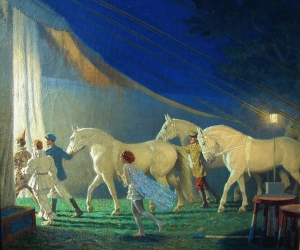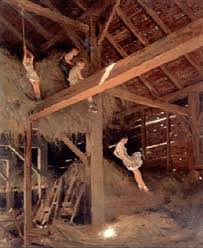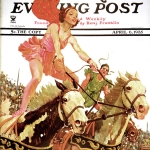Victor Coleman Anderson was the son of the Hudson River School painter, Frank Anderson (1844-1891). Frank Anderson died when Victor was eight years old, so except for inheriting native talent, there was little passed from father to son in terms of art. Victor Anderson’s primary training was at Pratt Institute in Brooklyn.
What intrigues me most about Anderson’s illustration (seen here) is his focus on the contrast of light and shadow. In Circus Performers the members of the troop move from the lantern lit dark outside the circus tent into the white light of the tent’s entrance. This path is in part defined by the string of white horses moving toward the light. The faces of the performers (two clowns, the costumed horse trainers, the three white horses and the young girl bareback rider) are all illuminated by the glare of the white interior light. The extreme brightness of the light from inside the big top tent causes the bodies moving into the light to cast elongated shadows. The parallel shadows echo the parallel rope lines above them. These lines hold the tent temporarily in place. Between these upper and lower lines the action of the painting is held.
I love the extreme whiteness of the horses and some of the performer’s costumes as they walk into the whiteness of the light inside the performance tent. This pristine fantasy of circus life might be compared to the way nothing stays as clean and white in real-life. It is as though Anderson was pushing the extreme fantasy of the circus and what we see there. Then there is the young lady equestrienne, the bareback rider who performs acrobatic and gymnastic feats as she stands atop the bare backs of her horses. Centered in the composition, her gossamer blue cape (called a tissu) sprinkled with sparkles is really just a glaze of blue paint for the cape and quick daubs of white for the sparkles. Most interesting is the fact above her left slipper (she will remove these before she mounts her horse) notice how Anderson had painted a slightly denser bit of paleness under her tights? I think that was meant to be seen as wrapping around her left ankle. So that even amidst all this white perfection, these amazing performers–this young girl is just a person prone to injury, as are we all.
It is interesting that among the recent auction listings for Victor Anderson’s work there are seven paintings focused on circus activities and one more, Children Playing in a Hayloft from 1925 that looks like children practicing trapeze performances. The only thing missing from this view into a hay-filled barn are the dust motes drifting in the dim light.
In the 1920s and 30s circus images were popularly used on covers of various magazines. Between 1931 and 1935 even the Saturday Evening Post printed three different covers of circus bareback riders by three different illustrators: E. M. Jackson, 4/25/1931; J. C. Leyendecker, 5/14/1932; and Maurice L. Bower, 4/6/1935 (see below).
Acrobatically skilled, bareback circus performers like equestrienne May Wirth (1894-1978) was famous for turning forward somersaults (called a casse-cou) on her cantering horse and even doing back handspring somersaults (called a flic-flac) from horse to horse as they cantered around the big top ring.* Like May Wirth, these talented women garnered the admiration and attention of those who witness them in action. No wonder Victor Anderson placed his young performer in the center of the action of his illustration.
* For more information on circuses, check out Circopedia: The Free Encyclopedia of the International Circus online at circopedia.org.
May 3, 2012
By Joyce K. Schiller, Curator, Rockwell Center for American Visual Studies, Norman Rockwell Museum









